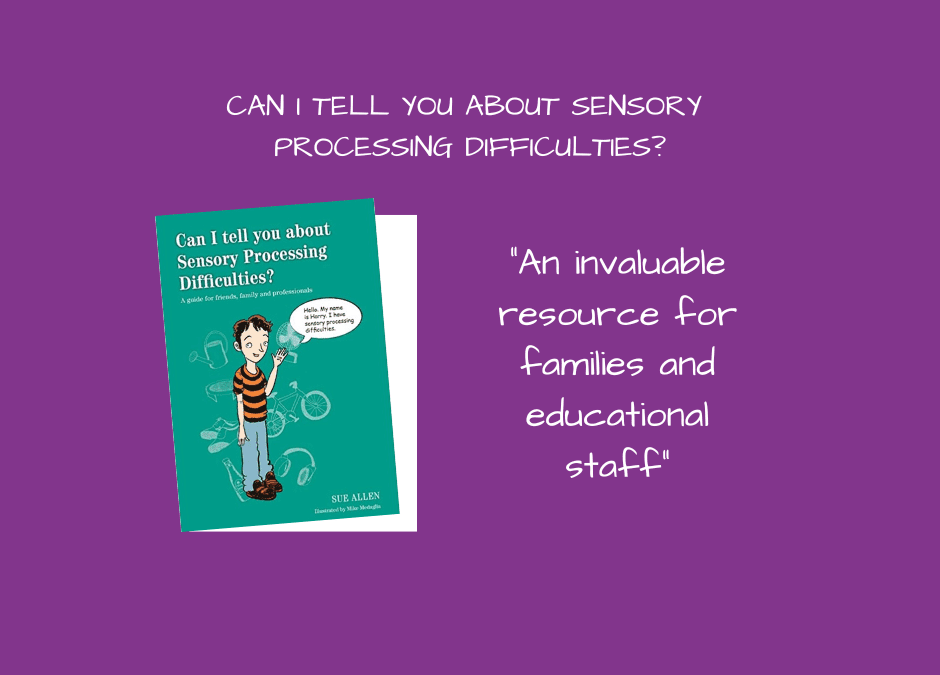Book recommendation: “Can I tell you about Sensory Processing Difficulties?”
by Sue Allen
This illustrated book is part of the educational,”can i tell you about,” series, aimed at children, parents and teachers.
The author, Sue Allen is an experienced clinician, clinical researcher, senior lecturer and occupational therapist. She was chairperson of the Sensory Integration Network from 2007-2013 and uses research into sensory processing, spanning over fifty years throughout this book.
This is an excellent book for any parent or teacher wanting to understand more about sensory processing difficulties and subsequent helpful strategies. It is very user-friendly, narrated throughout by our fictional guide, Harry and his sister, Anna.
Harry guides us through his sensory difficulties: touch, sight, sound, taste, smell, body awareness (proprioception) and movement (vestibular.) He gives examples of how everyday activities are affected and what helps in those instances. For example:
- (visual) Harry is over-sensitive to bright/fluorescent lights, wearing a hat and sunglasses in supermarkets helps.
- (sound) Harry struggles with loud sounds such as the school bell or shouting, wearing ear defenders helps.
- (touch) Harry hates having his nails cut, having a hug or massage from mum beforehand helps.
He describes eloquently in his words how his senses get muddled frequently, making it difficult to pay attention, complete school work and socialise with friends. When he’s overwhelmed, his senses feel like they are crowding in, making him want to retreat to a quieter place by himself. A pupil banging their pencil on the table is amplified, sounding like, “an invasion of elephants!”
By contrast, his sister Anna is under-sensitive with her sensory processing:
- (touch) Anna struggles to hold a pencil, using a heavier pencil and warming up with wheelbarrow exercises helps with writing tasks.
- (taste) Anna doesn’t notice taste flavours in food, often adding chilli sauce to her meals.
- (sound) Anna finds classroom instruction difficult to process, when teachers tap her hand or pat her back before speaking, this helps process the instructions.
Sensory processing difficulties are elucidated throughout this book, which will enable parents to read with clarity, perhaps resonating with their children. The wonderful part about this book is how effortlessly sensory diets/snacks can be incorporated into everyday routines:
- Star jumps can increase body awareness (proprioception), helping focus attention and organising body movements- great strategy before concentrated writing tasks.
- Learning and consolidating times tables by circling the number on skin with a forefinger- great strategy for Anna in maths classes.
- Weighted heavy blankets can help with sleep regulation.
The only slight criticism is that there is no reference to Interoception, often referred to as the 8th sensory system. This is the feeling of knowing what is happening in your body: hunger, thirst, temperature, or needing to pass urine. Some children might not notice or experience hunger or recognise that they need to pass urine. Alternatively, they may overeat to ward off hunger pangs, which they may find uncomfortable or go to the toilet frequently, despite not needing to pass urine.
This might be remedied with a later edition though, as at the time of publishing, interoception had only just started to be discussed on autism and sensory processing training within schools.
This is an invaluable resource for families and educational staff, full of clear, explanatory examples and crammed with helpful strategies for school and home management of sensory processing difficulties. Although the book is aimed at 5-11 year olds, it is probably more suited for children aged 7 and above, due to some of the more complex vocabulary and conceptual ideas.
Getting further help:
Where sensory difficulties are suspected, it is important to have an accurate, thorough sensory assessment, and access to therapeutic help.
The Purple House Clinic, Leicester, offers comprehensive sensory assessments and sensory integration therapy with an Occupational Therapist and Sensory Integration practitioner. The assessments take place in a fully equipped sensory room, with ball pit, play den, range of tactile objects and books.
Sensory screening is also available at our Rugby and Lincoln clinics, as part of the autism and trauma care pathways. As part of the trauma care pathway, children accessing therapy at The Purple House Clinic, Lincoln, have access to a sensory room, complete with sensory tent and bubble tube to help with sensory regulation. The Rugby Clinic can also offer full, sensory assessments through an Occupational Therapist.
The Glasgow clinic can offer comprehensive sensory assessments with an Occupational Therapist through home-visits, to help children feel more comfortable.


